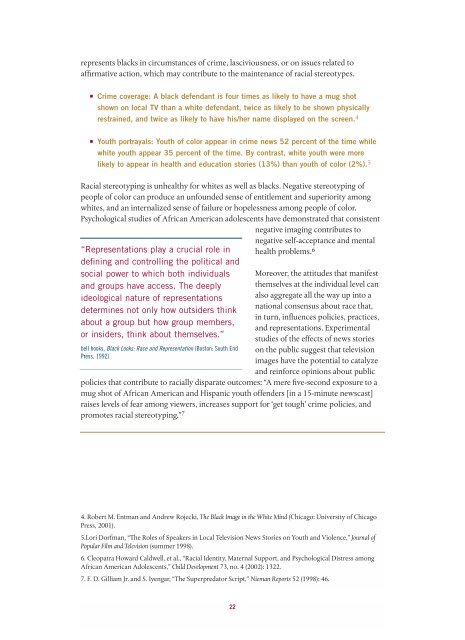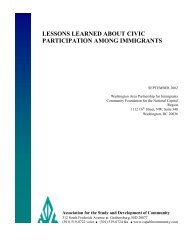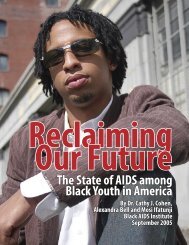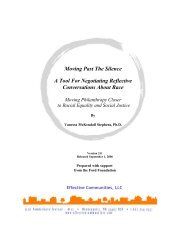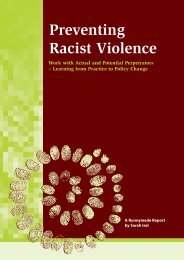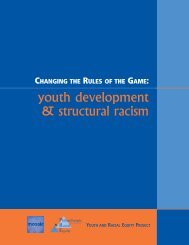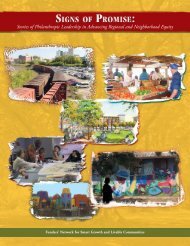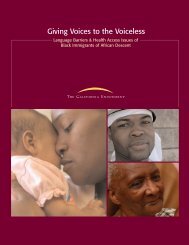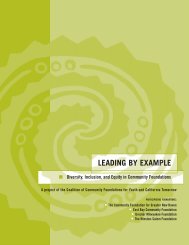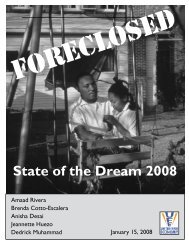Structural Racism and Community Building - The Aspen Institute
Structural Racism and Community Building - The Aspen Institute
Structural Racism and Community Building - The Aspen Institute
You also want an ePaper? Increase the reach of your titles
YUMPU automatically turns print PDFs into web optimized ePapers that Google loves.
epresents blacks in circumstances of crime, lasciviousness, or on issues related to<br />
affirmative action, which may contribute to the maintenance of racial stereotypes.<br />
e Crime coverage: A black defendant is four times as likely to have a mug shot<br />
shown on local TV than a white defendant, twice as likely to be shown physically<br />
restrained, <strong>and</strong> twice as likely to have his/her name displayed on the screen. 4<br />
e Youth portrayals: Youth of color appear in crime news 52 percent of the time while<br />
white youth appear 35 percent of the time. By contrast, white youth were more<br />
likely to appear in health <strong>and</strong> education stories (13%) than youth of color (2%). 5<br />
Racial stereotyping is unhealthy for whites as well as blacks. Negative stereotyping of<br />
people of color can produce an unfounded sense of entitlement <strong>and</strong> superiority among<br />
whites, <strong>and</strong> an internalized sense of failure or hopelessness among people of color.<br />
Psychological studies of African American adolescents have demonstrated that consistent<br />
negative imaging contributes to<br />
“Representations play a crucial role in<br />
defining <strong>and</strong> controlling the political <strong>and</strong><br />
social power to which both individuals<br />
<strong>and</strong> groups have access. <strong>The</strong> deeply<br />
ideological nature of representations<br />
determines not only how outsiders think<br />
about a group but how group members,<br />
or insiders, think about themselves.”<br />
bell hooks, Black Looks: Race <strong>and</strong> Representation (Boston: South End<br />
Press, 1992).<br />
negative self-acceptance <strong>and</strong> mental<br />
health problems. 6<br />
Moreover, the attitudes that manifest<br />
themselves at the individual level can<br />
also aggregate all the way up into a<br />
national consensus about race that,<br />
in turn, influences policies, practices,<br />
<strong>and</strong> representations. Experimental<br />
studies of the effects of news stories<br />
on the public suggest that television<br />
images have the potential to catalyze<br />
<strong>and</strong> reinforce opinions about public<br />
policies that contribute to racially disparate outcomes: “A mere five-second exposure to a<br />
mug shot of African American <strong>and</strong> Hispanic youth offenders [in a 15-minute newscast]<br />
raises levels of fear among viewers, increases support for ‘get tough’ crime policies, <strong>and</strong><br />
promotes racial stereotyping.” 7<br />
4. Robert M. Entman <strong>and</strong> Andrew Rojecki, <strong>The</strong> Black Image in the White Mind (Chicago: University of Chicago<br />
Press, 2001).<br />
5.Lori Dorfman, “<strong>The</strong> Roles of Speakers in Local Television News Stories on Youth <strong>and</strong> Violence,” Journal of<br />
Popular Film <strong>and</strong> Television (summer 1998).<br />
6. Cleopatra Howard Caldwell, et al., “Racial Identity, Maternal Support, <strong>and</strong> Psychological Distress among<br />
African American Adolescents,” Child Development 73, no. 4 (2002): 1322.<br />
7. F. D. Gilliam Jr. <strong>and</strong> S. Iyengar, “<strong>The</strong> Superpredator Script,” Nieman Reports 52 (1998): 46.<br />
22


